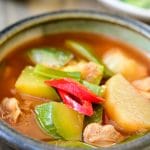
This gochujang jjigae (고추장 찌개) with zucchini is especially popular in summer when zucchinis are abundant and tasty. It’s a family favorite! If you like rich and flavor packed Korean stews (jjigae), such as soondubu jjigae, kimchi jjigae and doenjang jjigae, you should add this gochujang stew to your repertoire.

Variations for gochujang jjigae
For vegetables, zucchini and potatoes are typical for this stew. I also like to add chilli peppers and scallions. Other vegetables such as onions, mushrooms, or Korean radishes (mu) are all great additions to this stew.
In terms of protein, I use clams when I want a clean, refreshing taste of the stew. Other times, we also love pork for a rich, meaty stew. Both very delicious different ways! Canned tuna works well too for this stew.
If using pork (or beef), preheat the pot with a little bit of oil. Sauté the meat, gochujang and doenjang over medium heat for 3 to 4 minutes until the meat is almost cooked. You can add a little bit of water to prevent gochujang and doenjang from burning.
To make it vegan, simply omit the seafood/meat option. The addition of tofu and mushrooms will be great for a vegan stew. You can use vegetable broth instead of water for extra flavor.



Hobak Gochujang Jjigae (Korean Spicy Zucchini Stew)
Ingredients
- 1 medium zucchini - about 10 ounces
- 1 medium potato (2 small) - about 8 ounces
- 1 or 2 scallions
- 1 - 2 green or red chili peppers
- 1 teaspoon minced garlic
- 3 ounces clam meat (fresh or canned) or pork (see note 1 if using meat)
- 1.5 tablespoons gochujang (Korean red chili pepper paste)
- 1/2 tablespoon Doenjang (Korean soybean paste) or more gochujang
- 2 cups water or water used to rinse rice (ssalddeummul), water - see note 2. vegetable broth or anchovy broth is good too
Instructions
- Cut the zucchini and potatoes into about 1/2-inch thick bite size pieces. Roughly chop the scallion. Thinly slice the peppers.
- If using meat, see note 1 below. Otherwise, add 2 cups of water to a pot along with the red chili pepper paste and soybean paste. Stir well to dissolve. Bring it to a boil.
- Drop the potatoes in and bring it to a boil again. Continue to boil for a minute or two. Then add the zucchini, clam meat (unless using meat), garlic, chili peppers and scallions.
- Cook until the potatoes and zucchini turn soft. Serve hot with a bowl of rice.
Notes
- If using pork (or beef), preheat the pot with a little bit of oil. Sauté the meat, gochujang and doenjang over medium heat for 3 to 4 minutes until the meat is almost cooked. You can add a little bit of water to prevent gochujang and doenjang from burning. Then, add water (or broth) and follow the rest of the recipe.
- The water used to rinse rice is commonly used in Korean stews and soups. If using, save the water from the second round of rinsing.
The post Gochujang Jjigae (Gochujang Stew with Zucchini) appeared first on Korean Bapsang.